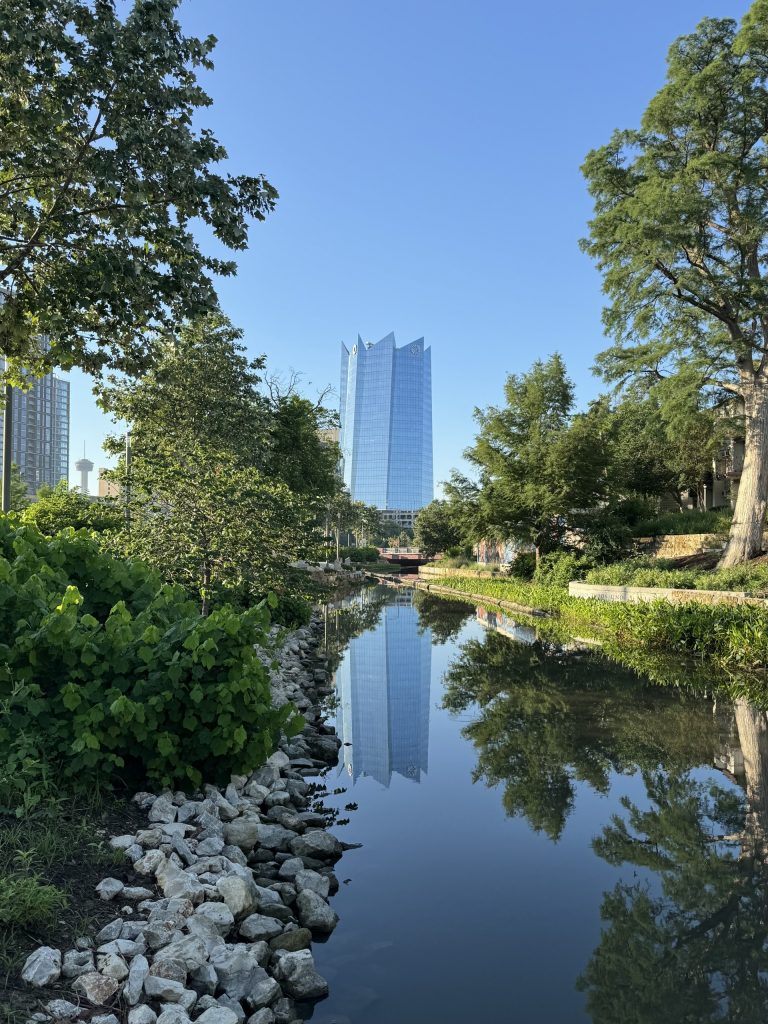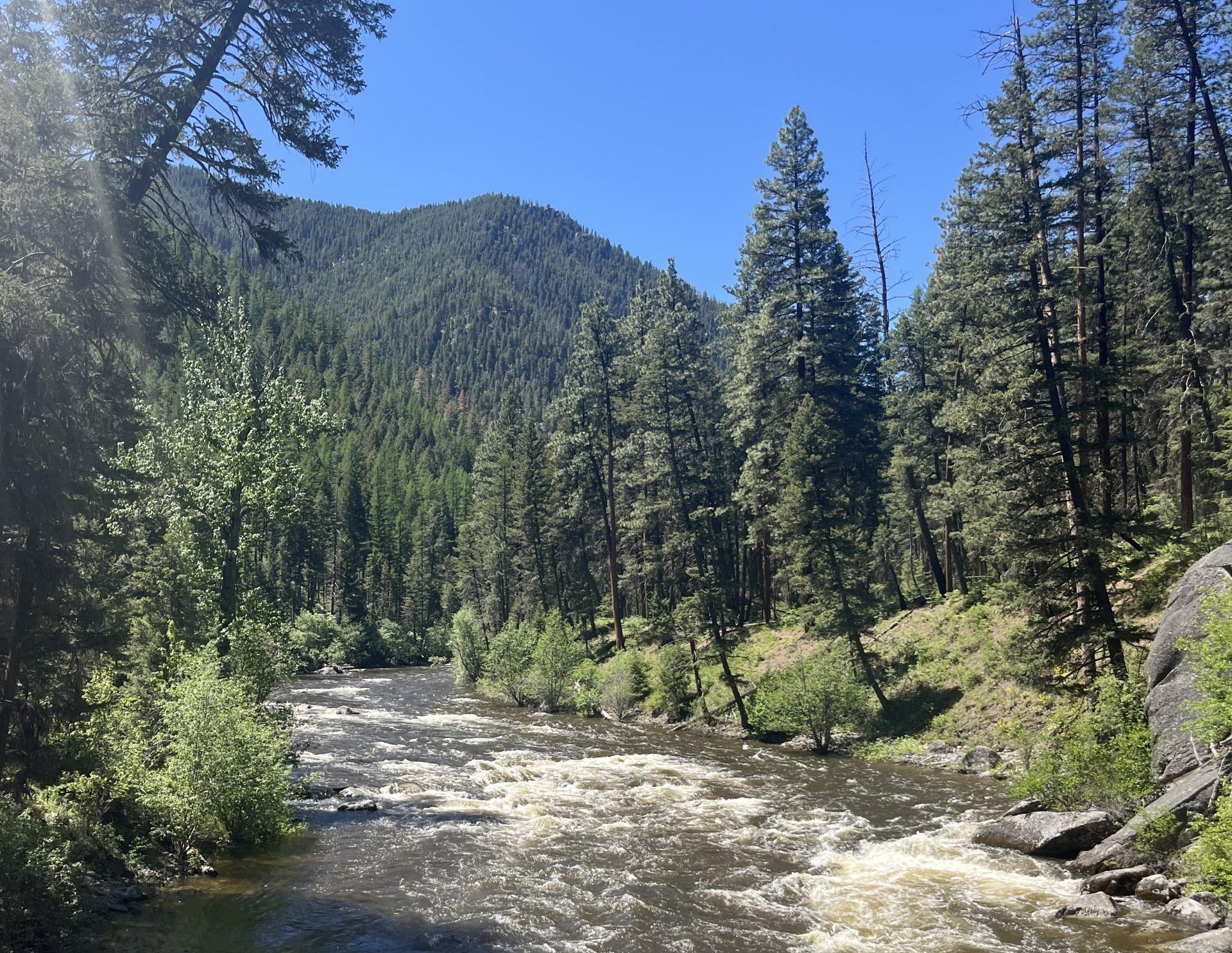
Picture a river.
Picture a river in the wilderness. What do you see?
Clear. Pristine. Does the water make a bubbling sound?
Do you hear the song of birds and the buzz of dragonflies? Are there trees and other tall plants swaying in the wind? Are there fish dancing below the waves? Does it smell sweet from flowers and dew? What color is the water? (see Figure 1)
A perfect little world…

Now picture a river in the middle of the city.
Does it smell different? Does the water sound different? Are there still plants and wildlife? Or does it look a little more like this?
An eyesore. Smelly. Full of trash. A mosquito magnet. And above all, silent. (see Figure 2) Do you ever look at it and think, does it have to be like this? Is this the price of flood safety?
Wouldn’t it be better if the wild river was closer to home? If there was an orchestra of water and wildlife a short walk away?
~~~
The capital “R” River
~~~

A river is fascinating at every scale:
In the channel are fish and other critters swimming by. Covering the rocks at the bottom of the stream is algae, and along the banks and floating in the water are aquatic plants, producing oxygen for the animal inhabitants. Framing the river are riparian plants, which keep their roots in soggy soil while stretching their stems toward the sun. They help to hold the banks in place. (Figure 3) Beyond them are larger plants, maybe trees, with even deeper root systems, in the “upland”, tilting their roots to access the water of the soil near the river. 1 2

Zoom in on the river. Between pebbles in the riverbed, a little creature makes their home. (Figure 4) Zoom in further, and see entire tiny worlds occupied by thousands of microorganisms.
Zoom out, and the little stream joins another and spills into a bigger channel, then another, then another, fractals from all over the landscape, converging and marching out toward the sea. (Figure 5)
❝…the earth shapes water, and the flow of water shapes the earth. Water is malleable but forceful. It grooves paths through the minerals it encounters, transforming rocks and dirt into sediment, transferring sediment from one site to another, and conveying this sediment over vast distances. Watersheds are water-sculpted environments.❞ 3

On a short time frame, the model of the River seems ordered, but change is happening all the time. Sediment is flowing from the headwaters to the delta. The river meanders as the water cuts against the banks little by little, becoming increasingly curved and sometimes looping back in on itself. Microhabitats are constantly being created and destroyed. When it is too hot and dry, many streams evaporate completely. On the flipside, floods tear up the riverbed and banks. Severe floods cut new pathways, changing the appearance of the watershed. 4 The most predictable thing about a river is its unpredictability.
Being an animal in the water is a lot more challenging than it looks; when conditions change, some will migrate or even burrow into the riverbed and wait it out. 5 Then the conditions will change again. A river is always in flux, and its inhabitants must be resourceful. That includes us. (Figure 6)
~~~ River People ~~~
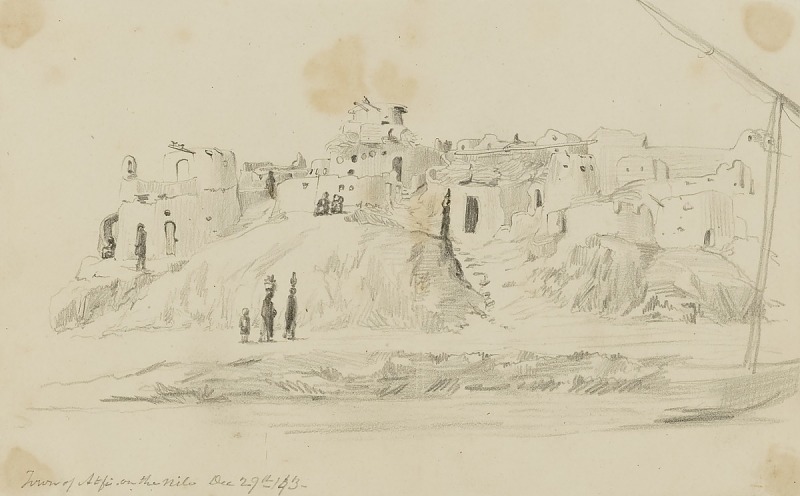
Humans have always needed rivers. (Figure 6) The Nile in Egypt. The Tiber in Rome. The Yellow River in China. Where there is a river, you’re likely to find people. Throughout time we have built great civilizations around rivers, using them for trading, fishing, drinking water, and agriculture. 6 For example, human presence in the San Antonio River watershed has been recorded for more than 12,000 years. Before the Spaniards arrived, the area was populated by the Payaya people, who called the river “Yanaguana”. 7 8
❝From its headsprings the river burst from the earth in one mighty gush of water… because of the river the city was born.❞ 9
One of the most valuable ecosystem services the River provided to people was the gift of the flood. (Figure 7)
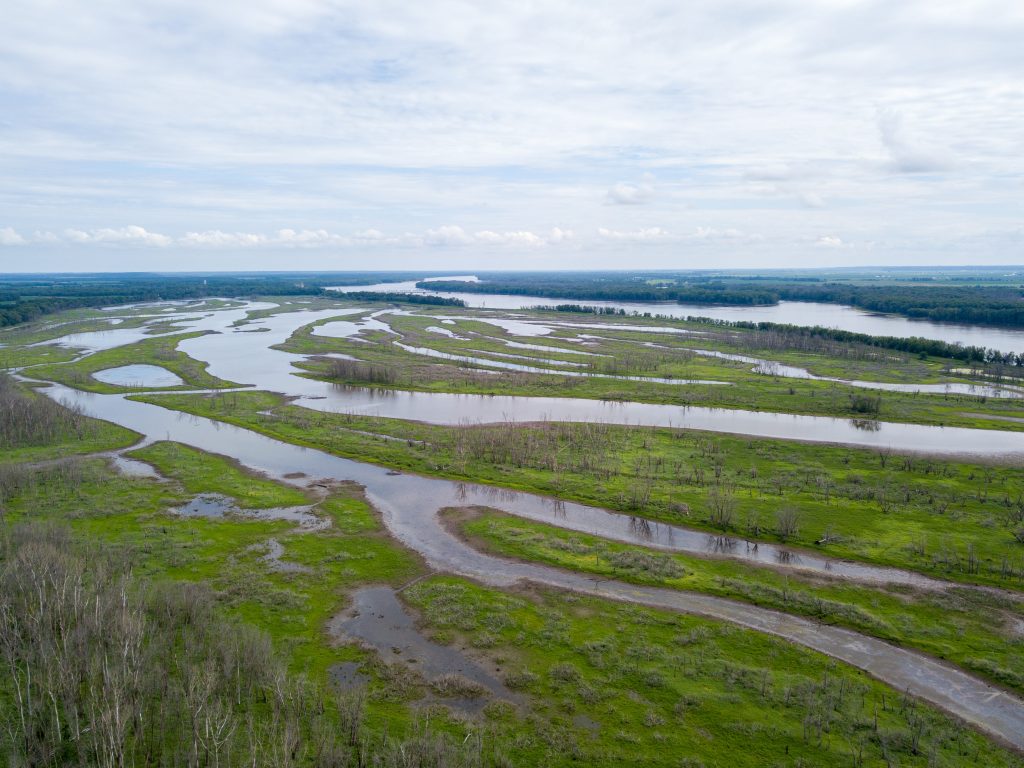
The flood is an underappreciated part of the river lifecycle. Floods are how rivers clean themselves. When a river overflows its banks, it redistributes not just water, but sediment. The increased volume of water moving at high speeds tears up the riverbed and releases plumes of nutrients trapped below. This nutrient-rich sediment is deposited onto the surrounding lowlands (called a “floodplain”). The bigger the flood, the more sediment deposited over a wider area. 10 (Figure 7) Once the water recedes, the dirt is left behind, and when seeds find the new soil, they germinate and feast. They grow vigorously and flower faster, attracting more pollinators and producing more fruit. 11
The flood was known by our ancestors as a source of prosperity that came on a regular timeframe. People planted crops on the floodplain, eagerly awaiting the next flood. And where there was a reliable place to find food and water, more people migrated to the area. And if there were more people then you had to plant more crops. And thus the River is what gave birth to human civilization on every continent. 12
~~~ From Friend to Enemy ~~~
We mostly think of ecological devastation as introducing chaos into an ordered system. But when it comes to the River, ecological devastation has also come in the form of attempting to bring too much order to a beautifully chaotic system.

The Industrial Revolution completely changed the way we interact with and think of the River. Where rivers once were the seat of agriculture, they became the center of industry, the source of power for factories with inventions like the water wheel turbine. (Figure 8) The steamboat made trading on the river easier than ever. And once the River became the place where people went to work, more people started to build settlements around rivers, overcrowding them. 13 In short, industrialized countries experienced rapid population growth that put more pressure on the urban environment.
Our philosophy also changed. Indigenous societies often viewed the River as a living system and a community of which we, plants, and animals are equal parts of. However, within the framework of an industrial capitalism focused on profit above all else, we started to view ecosystems as harbors of undeveloped natural resources ripe for exploitation. (Figure 9) 14 15
❝Alexander Powell, writing for Sunset magazine in 1913 about new irrigation projects, proclaimed that “nowhere has the white man fought a more courageous fight or won a more brilliant victory than in Arizona[‘s desert rivers]. . . . The enemy which he has conquered has been the most stubborn of all foes—the hostile forces of Nature.” … part of the water hubris mentality is the belief that society has a moral right, or at least deserves, to conquer rivers—sort of the water version of manifest destiny… ❞ 16

This was the beginning of the end for the River.
First, the River was poisoned. More people means more waste, and good sanitation hadn’t been invented yet. So people dumped their household garbage into the river. (Figure 9) The stink blanketed entire cities. Factories added several magnitudes more waste than households, much of it filled with toxic chemicals. (Figure 8) These problems overwhelmingly impacted poor and marginalized communities. 17 A combination of redlining and pollution led the river to be seen as unclean and uncivilized. 18 For example, when the San Antonio Museum of Art first opened on the banks of the San Antonio River in 1981, the river itself was decidedly not part of the exhibits; it was nothing more than a forgotten drainage ditch. 19
❝The river itself was polluted and unfit for decent human activity, and urban riparian zones often consisted of abandoned warehouses and dilapidated buildings, crowded with failed dreams and moral lapses… Down by the river was
the no-good part of town.❞ 20
Second, the River was neutered.

For all the beautiful imagery I used before, the River is no saint. A cute little stream can turn into a raging beast in a matter of minutes. A large volume of water coming at high speeds carries an incredible amount of force with it. (Figure 10) Less than a foot of floodwater can flip a car over. Plus, the water will be carrying projectiles in the form of broken branches, rocks, and anything it has already mangled. 21

This was less of a problem before industrialization and major cities, because people used the flood for agriculture; not many people actually lived on the floodplain. But with the increase in development upon floodplains, there was little cropland to benefit; just a whole lot of people and a whole lot of buildings in the way. 22 And so the flood, once a symbol of prosperity, had become the enemy: drowner of innocents and destroyer of property. Severe floods are dangerous turned into all flooding is dangerous turned into the River is dangerous and needs to be controlled.

A muzzle was slapped on the River. It was diverted, it was drained of its lifeblood. It was castrated and cut into a thousand pieces. It was walled off, it was buried 23, it was dammed. It was stripped of its plants and rocks and life, stripped down to its bones and forced into a nice pretty little concrete channel. 24 (Figure 11, Figure 12)
Humanity had done the impossible. We had tamed the beast and stripped it for parts. Once the humans had been at the mercy of the River, dependent on its services, prey to its power. Where we had once built our cities around the River, now we were going to build the River around our cities. (Figure 12) According to our laws and our desires.
And so all of a sudden, it was quiet. There were no more raging rapids. But also no more birds. No more bees and dragonflies buzzing about. No more cattails swaying in the wind. No more fish leaping over the rocks. Just a deafening silence.
The channelization of streams keeps water from trickling into the ground, which cuts off its access to aquifers and is more likely to hold it in place until it evaporates. The combination of concrete and lack of vegetation heats up the water, leading to a decrease in dissolved oxygen, limiting the stream’s ability to support life. The straightening of the channel increases stream velocity, making it more dangerous to stand in the channel and worsens erosion. Habitat for fish, invertebrates, and amphibians are destroyed. The cutting off of the river from the floodplain leaves nearby plants starving for water. 25
Isn’t that just the price to pay to protect our cities?
Except… some beasts can’t be tamed.
~~~ Broken Rivers and Broken Promises ~~~
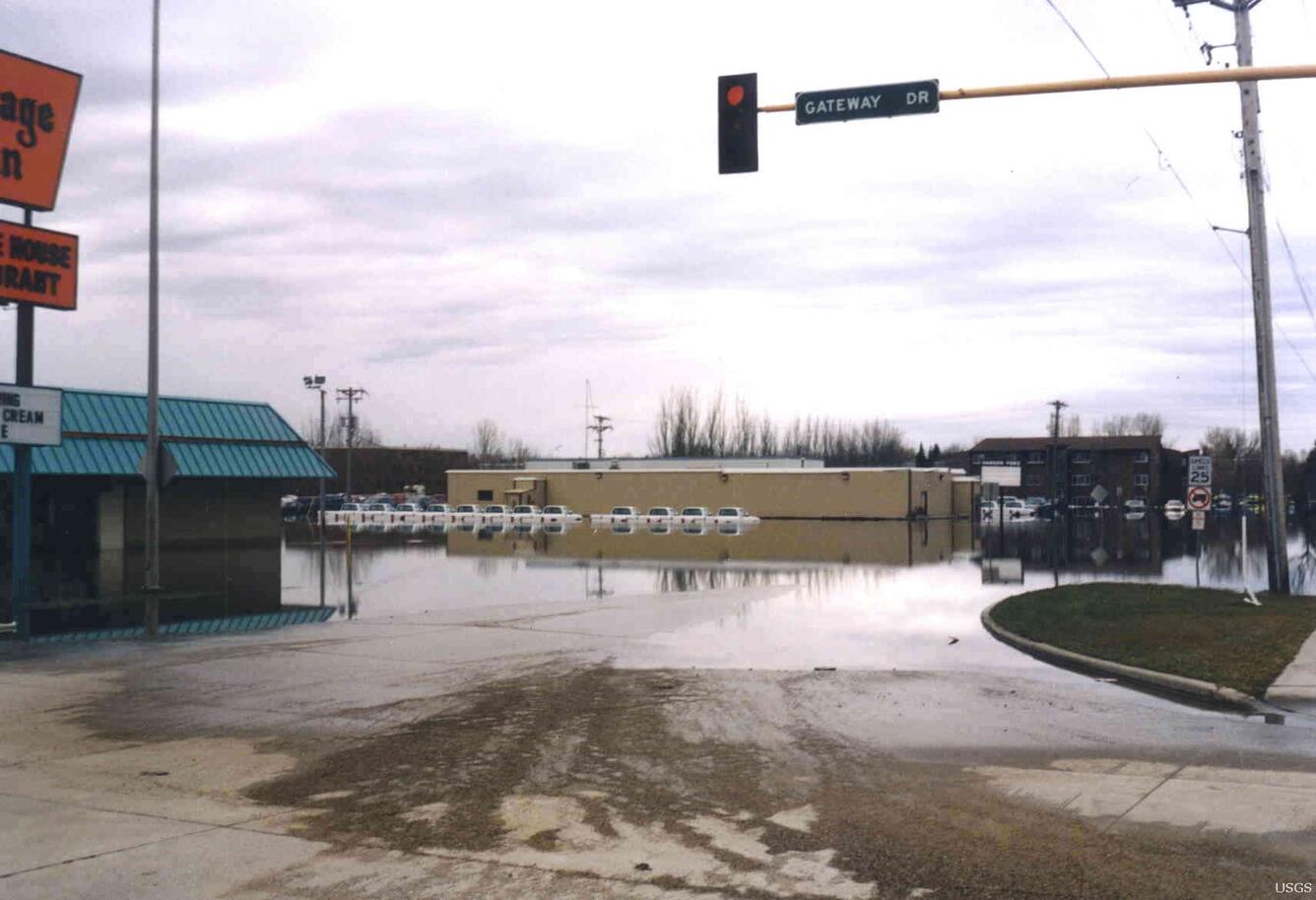
❝When rivers are constrained, they ultimately lash out violently. There must be numerous outlets to the floodplain to allow the water to dissipate its volume… there is no such thing as flood “control.” Highwater can be directed, but it cannot be stopped… no set of defenses is foolproof.❞ 26
Over the course of the 20th century, urban populations continued to grow. Floods also continued to happen. (Figure 13) Cities kept slapping a band-aid on the problem with grey infrastructure in the form of dams, culverts, weirs, flood reservoirs, and concrete channels. 27
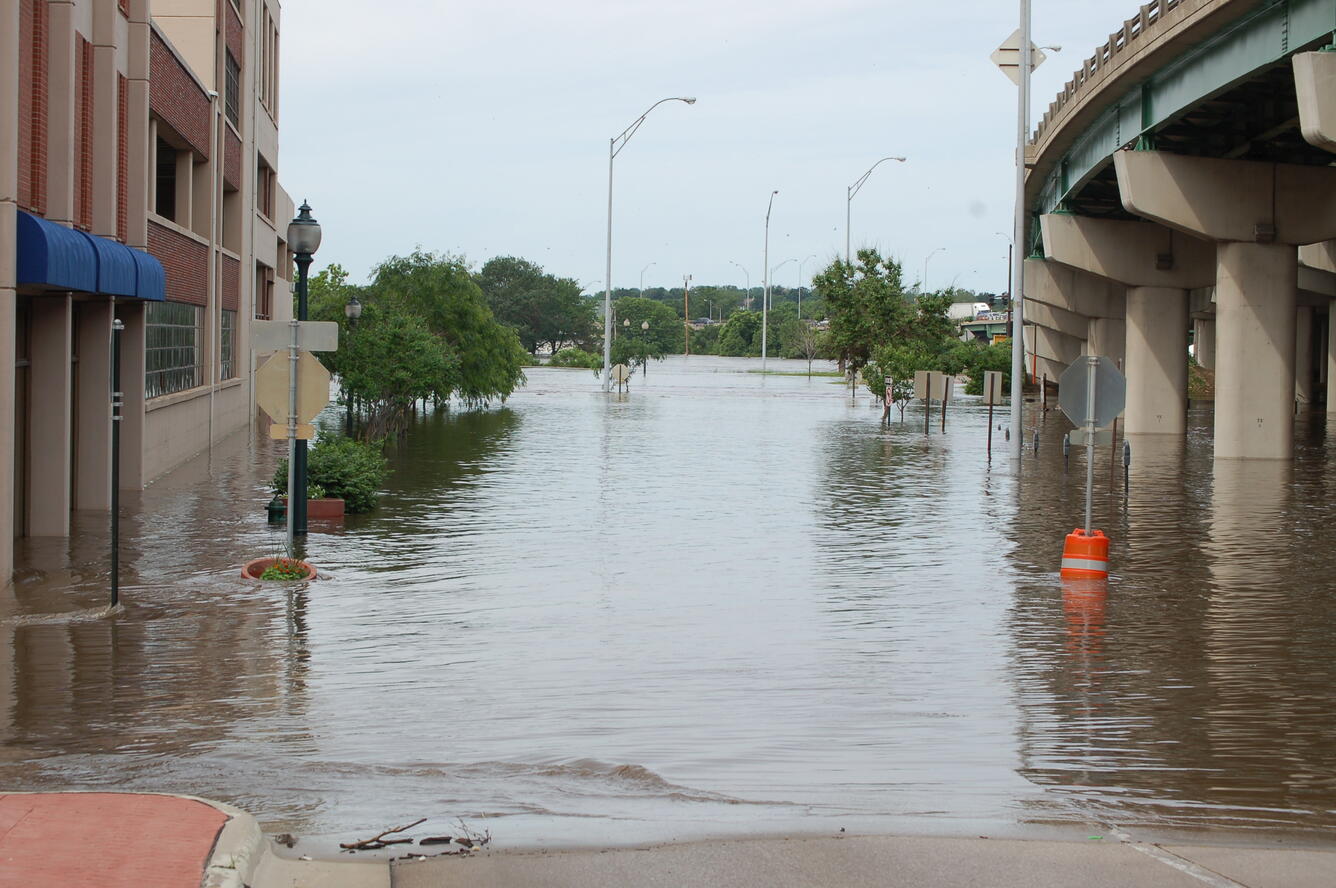
But it turns out that grey infrastructure might actually be making the problem worse. (Figure 14) A core part of contemporary urban design is impermeable surfaces, which are exactly what they sound like. Water cannot trickle down through concrete. So instead it runs right off, runs downhill, tries to find the lowest point to puddle. 28
The pattern of floods in urban areas arriving faster and with more volume is called flash flooding. You’ve probably heard of it on the news. When rain is light and flooding is mild, grey infrastructure can handle it, but when the rain starts pounding down and rivers rise rapidly, grey infrastructure is ill-equipped. (Figure 14) And climate-fueled weather events are just making it worse. 29 A study that compared potential solutions to reduce flash flooding on the Acari River in Rio, Brazil, found that while grey infrastructure and green infrastructure both reduced flooding, the green infrastructure approach was more efficient at reducing flooding. 30
Flash floods in the latter half of the 20th century made it obvious that the channelization of rivers had failed in its prime directive. At the same time, many people around the world were becoming increasingly educated about ecology and the value of what we had lost. People missed the birdsong and the gentle flow of the River. 31
Public pressure fueled the passage of environmental protection legislation, which in turn provided the framework for restoration efforts across river habitats. 32 River habitats were no exception.
~~~ Hope ~~~
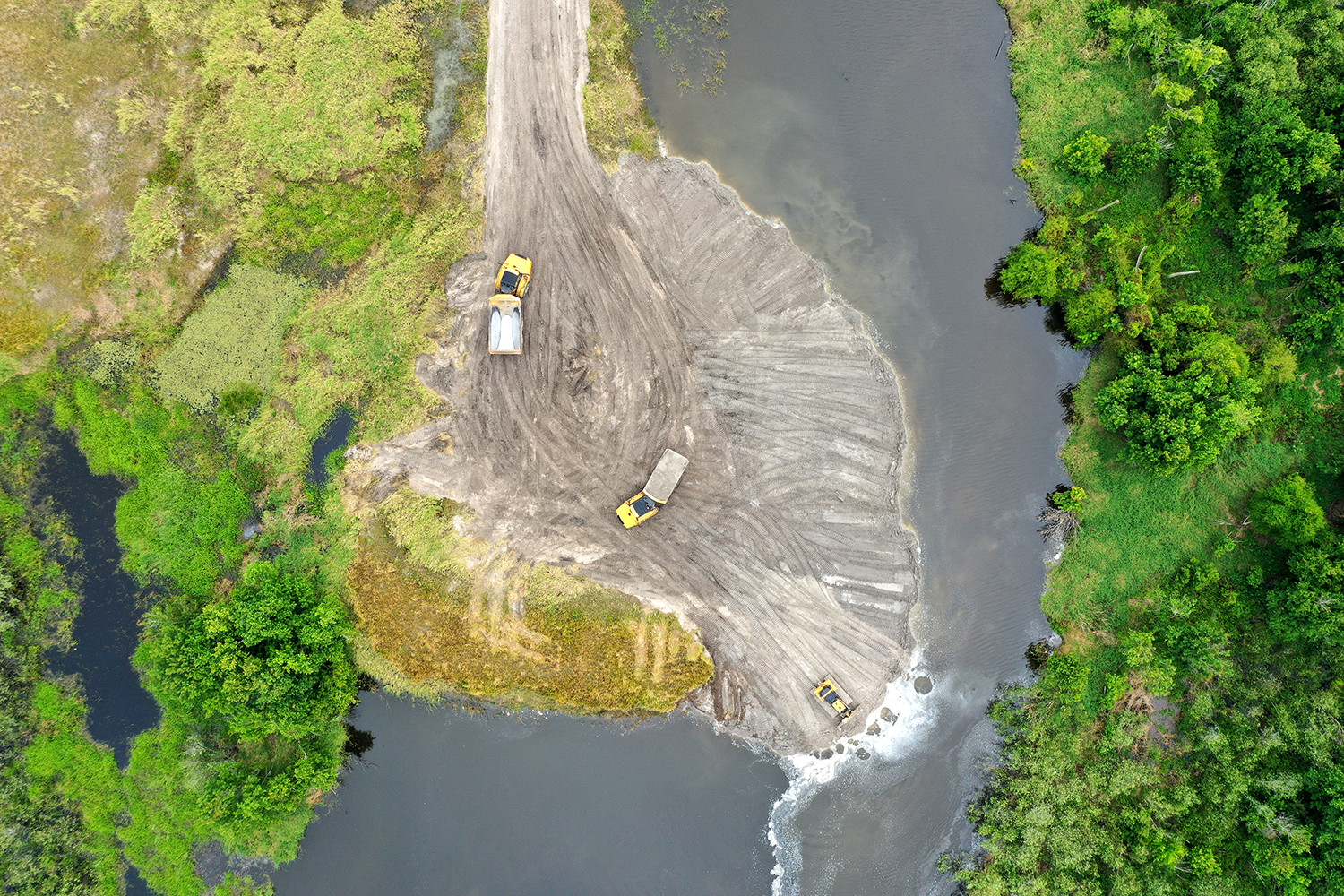
❝Many of our rivers are wounded, but they are not dead, even if they have been dammed, drained, or poisoned… The right combination of science, politics, and enthusiasm can revive them.❞ 33
In the United States, the Clean Water Act of 1972 and its amendments imposed water quality standards and gave the US Army Corps of Engineers (USACE) powers over wetland protection and development on lands considered wetlands. The Water Resources Development Act (WRDA) of 1996 went further, instructing USACE to “partner with state and local governments and non-governmental organizations to implement aquatic ecosystem restoration projects to improve environmental conditions.” (Figure 15) 34
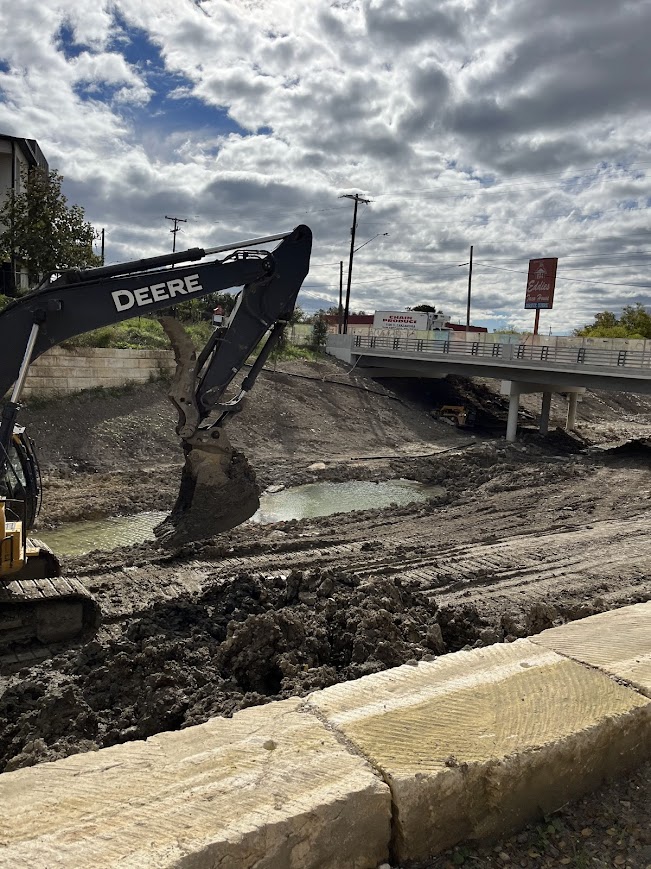
In San Antonio, river restoration was prompted by the 1973 San Antonio River Corridor Study, and in 2000, Congress approved funding for the San Antonio River Improvements Project. By the end of the 2010s, USACE had partnered with the San Antonio River Authority to restore 13 miles of the San Antonio River ecosystem. 35 Since then, the USACE has approved the Westside Creeks Ecosystem Restoration Project, and San Antonio is working to restore more of its watershed. 36 (Figure 16)
River restoration is a global phenomenon. In the late 1990s in Hong Kong, green elements started to be incorporated into flood infrastructure, and over 20 channel sections have been restored since. 37
The EU passed the Water Framework Directive (WFD) in 2000, one of the most comprehensive water protection policies of the century. 38
In Munich, Germany, where talks about restoring the Isar River started in the 1970s, the WFD’s passage prompted restoration efforts to begin. Construction was completed in 2011, and Munich has since become a model for successful river restoration with its interagency collaboration, public involvement. The effects of restoration have been notable, with improved water quality, and healthier bird and fish populations. 39
The Netherlands have also made impressive progress on their river networks. The Gelderse Poort project rewilded 5,000 hectares, and the Border Meuse project, still underway, is projected to be Europe’s largest river restoration yet. The project is designed to cope with a 250-year flood event, and has controlled flooding so far. 40
❝Driving the length of the restored river… is like being in a time capsule. Some of the older sections of the project, further upstream, are already thronging with life. Borgharen, an area which has been farmed since at least Roman times, was one of the first sites to be let go. [Now] dozens of sand martens are speeding into the cliff by the river to feed their chicks; there are blackcaps, stonechats, skylarks and swallows in the sky.❞ 41
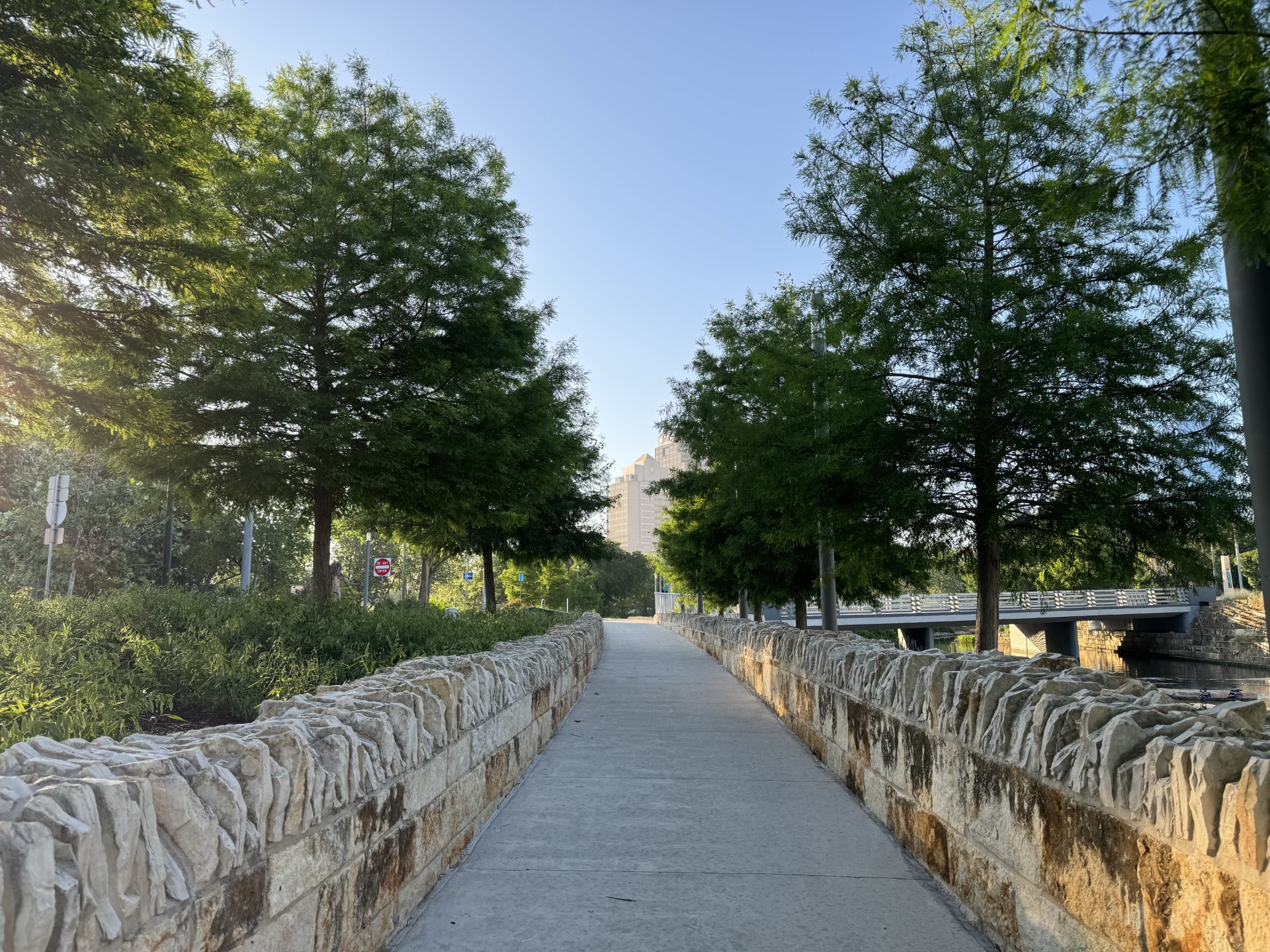
In Colombia, river restoration projects have been happening since the 1980s, and the city of Monteria built the country’s first large-scale linear park in 2002. (see Figure 17) 42 Across Latin America, restoration efforts have been guided by various cities’ “Master Plans” for urban development, which have demonstrated an excellent understanding of the ecology of rivers and the importance of multifunctional landscapes and sustainable water management. The trend is spreading beyond Colombia to Chile, Mexico, Ecuador, Panama, and the Dominican Republic. In Mexico City, activism triggered the unburying of a river and transformed it into a park. Costa Rica has established “Interurban Biological Corridors” spanning several cities. 43
~~~ Trends and Techniques in River Restoration ~~~
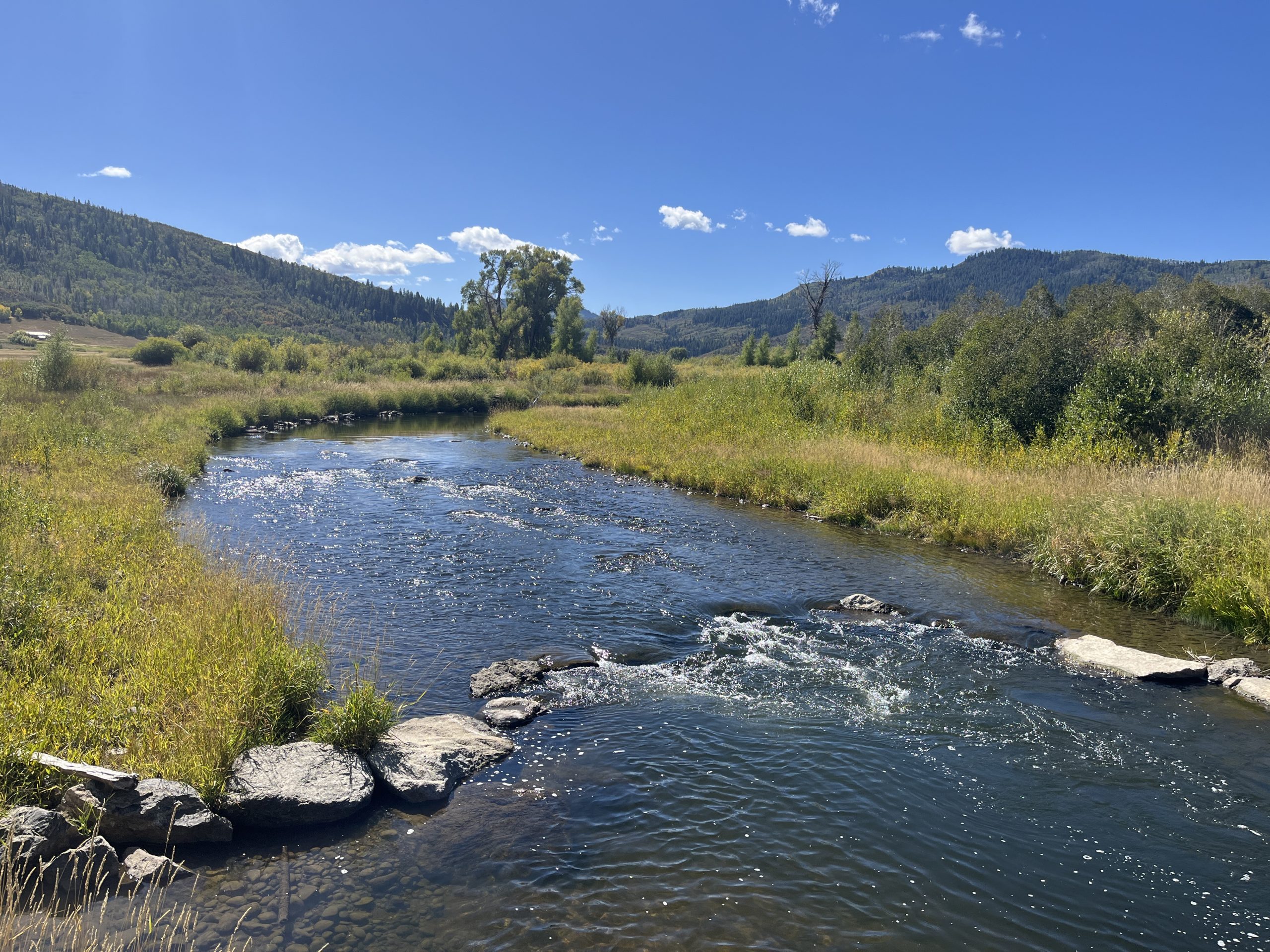
A European study found that the number #1 driver for river restoration projects was to seek improved biodiversity, 44 and this sentiment is shared around the world. Over the past few decades, restoration efforts have included installing native riparian plants along river banks and removing invasive species 45, and river channels have been modified to promote the recovery of fish and invertebrate populations, with construction of cross-vanes (Figure 18), pool-riffle structures, oxbow lakes and the use of logs and boulders to create habitats. 46 47
Another common purpose of restoration is to improve water quality. Before any work can be done, however, pollution has to be stopped at the source; chemicals have to stop being released into the river.
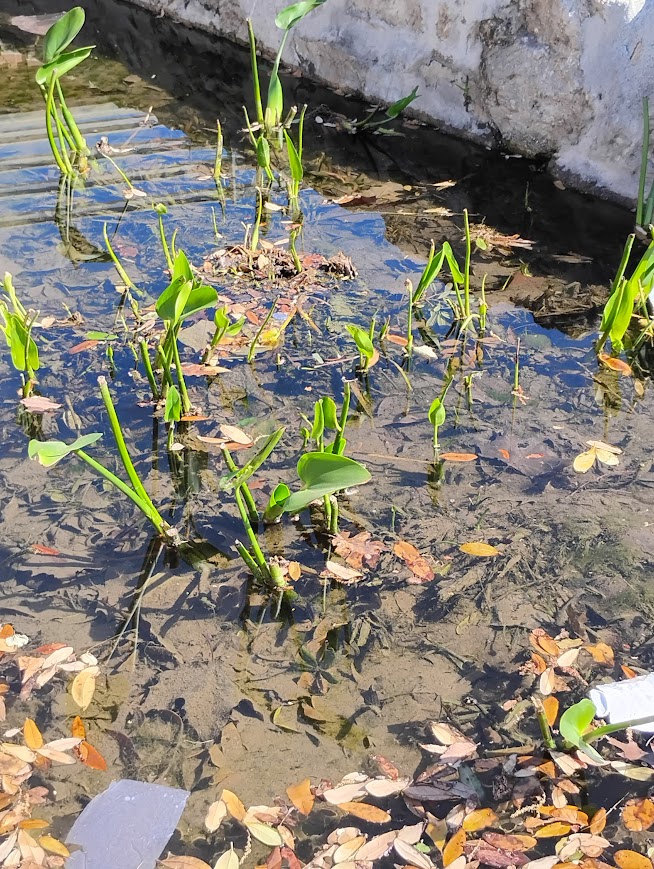
Thankfully, in developed countries with good enforcement mechanisms, “point pollution” (ie. dumping or leakage of chemicals) has been greatly reduced thanks to legislation like the Clean Water Act and the Water Framework Directive. So water quality-based river restoration tends to focus on stopping and mitigating the effects of “non-point” pollution, which doesn’t come from one specific source but is, in part, the result of stormwater runoff picking up contaminants from urban areas. 48 49
This is a steep goal, as water quality is complex, involving many different factors. Nonetheless, efforts to improve water quality have included floodplain reconnection and rebuilding wetlands. In addition to providing biodiversity benefits, wetlands keep polluted water out of the river channel by filtering contaminants. 50 Bioswales, designed to mimic wetlands, have been constructed containing specific plants and microorganisms that are good at keeping pollutants out of the river. (Figure 19) For example, in San Antonio, the San Antonio River Authority constructed bioswales on East Saltrillo Creek to filter stormwater coming off of a high school campus. 51
Not unrelated to the issue of water quality is the issue of water quantity. In the arid and semi-arid regions of the southwestern United States, where warming temperatures mean water is rapidly disappearing and land is desertifying, a common purpose for river restoration is to maximize river flow. This involves managed flood releases from dams, reduced groundwater pumping, improved irrigation efficiency, and purchase/ lease of water rights from landowners. The managed flow releases from dams in particular mimic the natural boom-and-bust cycle of rainfall in the region, and promote plant growth on the floodplain. 52
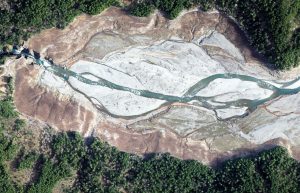
Complete removal of dams can have immediately beneficial effects on rivers, but is a delicate task because of the sediment and debris held behind the dam wall; the challenge of a release is to avoid choking the river in a massive debris flood. (see Figure 20) Not to mention the importance of dams in serving as a source of cheap renewable energy and recreational benefits. 53
❝Trickles became waterfalls, and stagnant shallows became deep turquoise pools.❞ 54
Flow management-related projects are some of the most expensive methods of restoration, not just because of the need to remove or modify existing infrastructure, but because of the need to get consent from landowners to give up their water. 55
Of course, restoration efforts can overlap. A study to map barriers on the Morava river basin in Germany found that “…specific objectives (e.g., pollution and erosion mitigation) may benefit from an integrated strategy, whereas others (e.g., tourism-driven restoration) require more targeted approaches.” 56
~~~ River Repair and the Social Element ~~~

Some scientists argue that the term “river restoration” is misleading. With all of the pressures humans have exerted on rivers throughout time, it may be impossible to ever restore them to a state that looks and acts the same as it did before human intervention. Humans aren’t going anywhere anytime soon, and our large population will continue to exert pressures on river ecosystems. That doesn’t mean that we shouldn’t try to improve the environment, just that we may have to do so in a way that serves both humans and the environment. 57 (Figure 21)
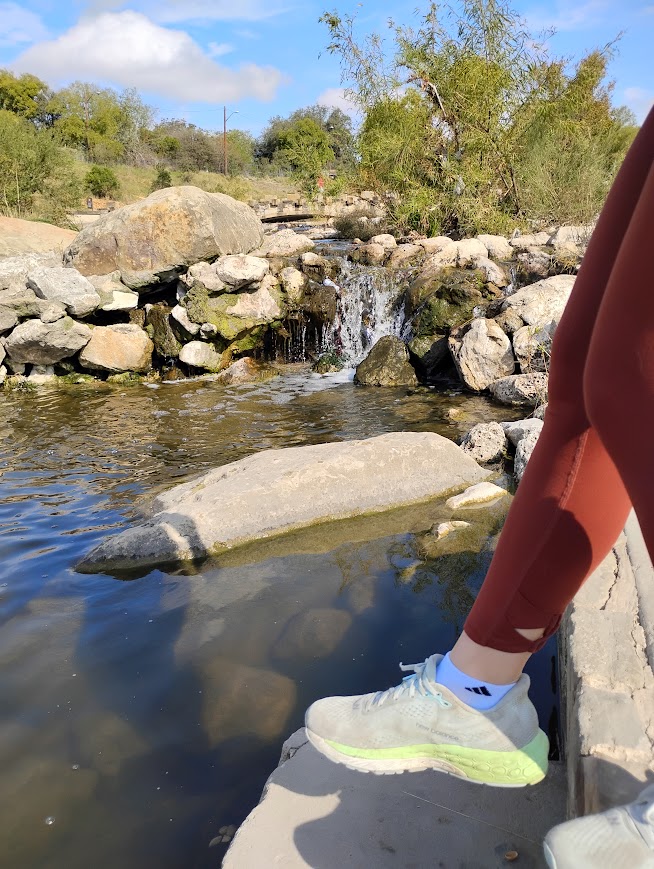
Because humans are part of the environment, trying to extricate ourselves from the river ecosystem is simply not possible, nor does the attempt produce good results. Pre-history and indigenous communities lived alongside rivers in harmony for thousands of years before industry or plastics or concrete were invented.
Furthermore, how can we return a river to its original state when we do not know what the original state was? After all, human intervention has been happening to rivers for hundreds of years. 58
If we can’t bring a river in a city back to a pristine natural state, then we have to do something else. We have to create more sustainable infrastructure that balances human needs with ecological needs. (Figure 21, 22, 23) Some call it “river repair” or “stream rehabilitation”. Whatever you call it, it’s clear we need our conservation dreams to be in line with reality in these more urbanized and industrialized times. 59 60
So what can we do?
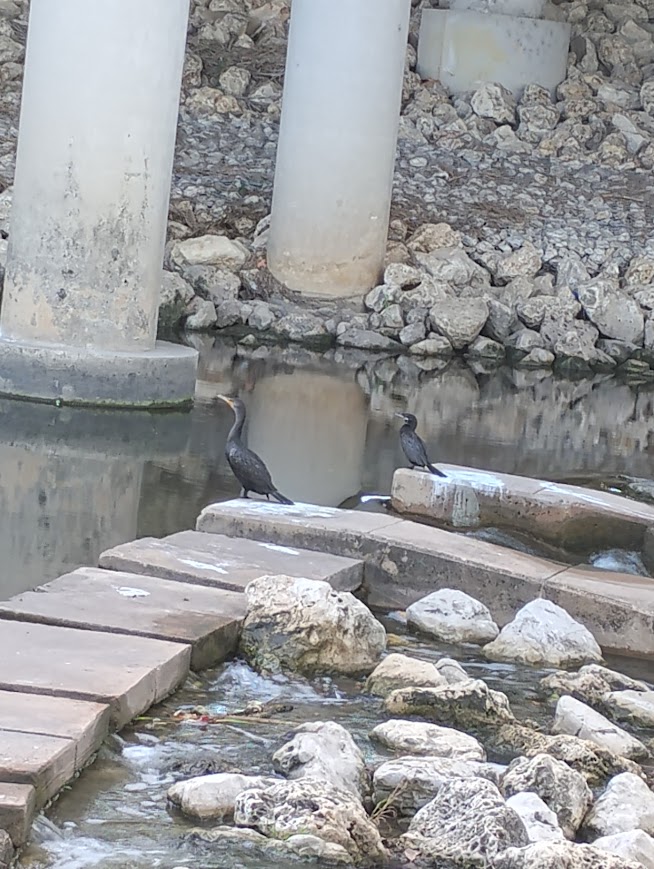
As pointed out by Wohl, Lane, and Wilcox 61, “rivers should be seen as a hybrid of nature and culture”. Rivers should be as natural as possible, but they also need to be accessible to the people who live by them. A great example of this is the river channel designs done here in San Antonio by the SA River Authority. 62 (Figure 24)
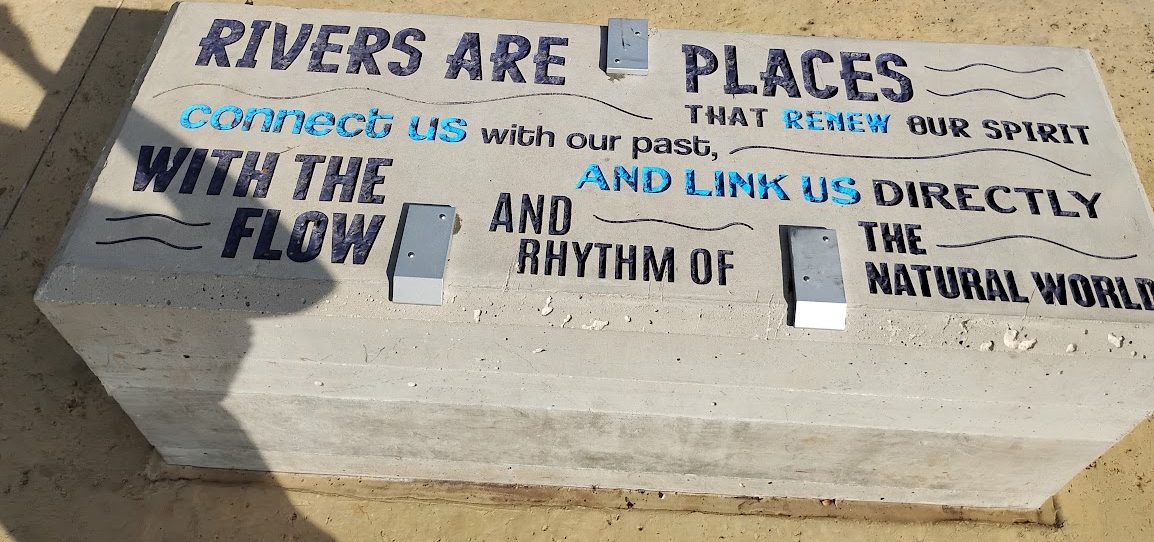
San Antonio’s designs are addressing a serious problem in river restoration as perceived by the public, which is that the public often only see river restoration in the context of water quality, biodiversity, or flood control, and often do not recognize the cultural and recreational benefits of rivers. (Figure 25, 26) “…there is a larger body of research focused on river water quality, which has led to greater public awareness and understanding of its importance…” Dr. Yinan Dong from the Southern Federal University in Russia points out. “… in contrast, fewer studies have examined the recreational value of river environments, resulting in limited recognition of their significance among the public…” 63
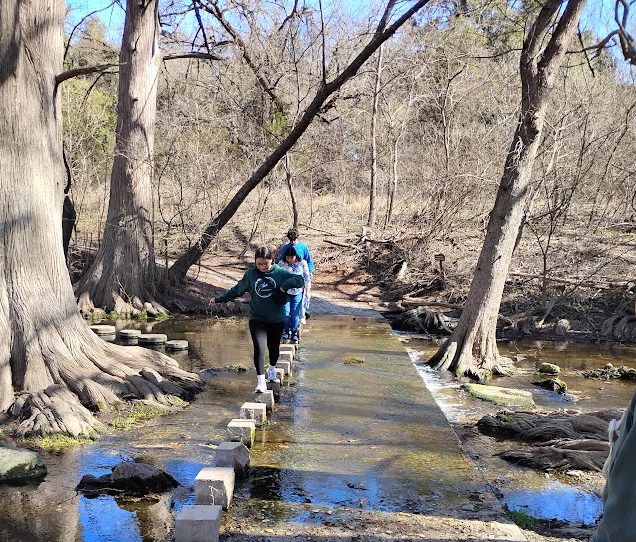
For rivers to be seen as educational and cultural centerpieces (Figure 26), we also need to do a better job of integrating the public into decision-making around river restoration. After all, it was activists who first sparked the change to restore our ecosystems. 64 To ignore the importance of the public in river restoration would be a disservice.
This is another area where San Antonio leads; the 1998 “San Antonio River Oversight Committee” was a local stakeholder group that advised the city on its river and infrastructure projects, and in 2003 the River Authority created the “San Antonio River Foundation” to “…raise private money to bring artistic, recreational, environmental and educational enhancements to the river.” Murals line the walls along San Pedro Creek Culture Park, and the Museum Reach and Mission Reach provides easy walking to nearby museums and culture centers, not least of all the historic Spanish Missions.65 However, more work can be done to educate and include the whole of the public.
When we don’t involve the public and acknowledge the intersectionality of environmental justice, rehabilitating rivers can become another opportunity to mask gentrification. When practioners of river restoration forget about social issues, developers can gobble up prime riverfront property and keep out the poor (Figure 27)– but when the public is included and cities have an understanding of social issues, river restoration will benefit everyone. 66

Today, where and how restoration efforts happen cannot be disentangled from the socioeconomic environment. For example, a study of three restored rivers in Hong Kong that compared urban & suburban environments, found that the amount of channel modifications in the urban river was limited in comparison to the suburban rivers. The suburban areas were populated by older and wealthier residents. Surveyed after restoration, urban residents said that while the air and auditory (sound) environment had improved, they were still not at desired levels. In contrast, the suburban residents expressed clear improvements in their quality of life because of the river restoration. 67 The ability of the municipalities to fund high-quality restoration projects made all the difference.
And in developing countries, even though there is clear interest for river restoration, and there is guiding legislation available, implementation and law enforcement are lacking. This has made cost-saving measures the priority, which may not produce the greatest biodiversity benefits. 68
~~~ River Resilience ~~~
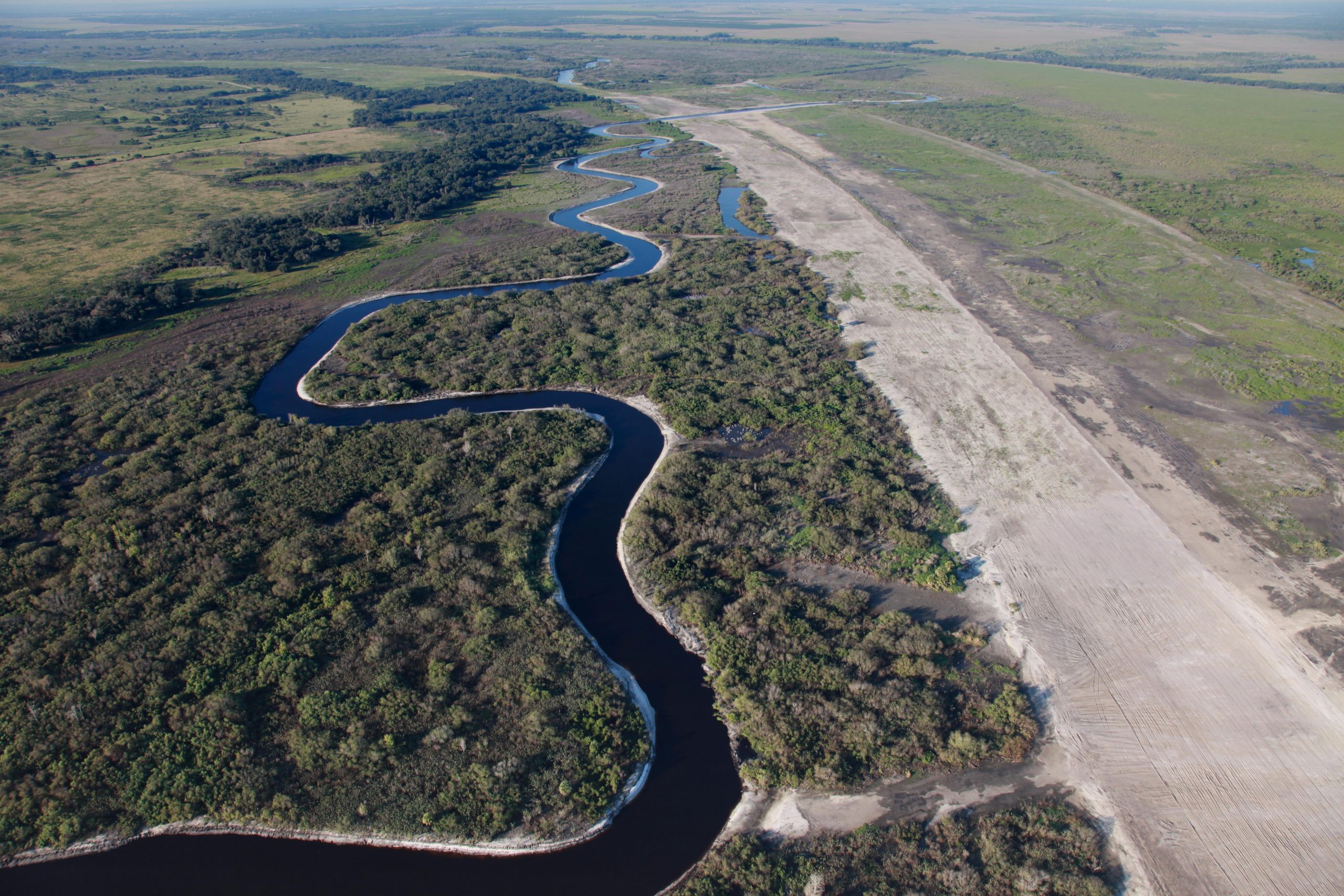
❝River ecosystems exhibit a natural or historical range of variability in relevant parameters such as flow and sediment regimes, channel form, or biological communities as a result of disturbances and other changes in external forcing… restoration must embrace the restoration of diversity and not simply restoration of a particular river structure or form.❞ 69
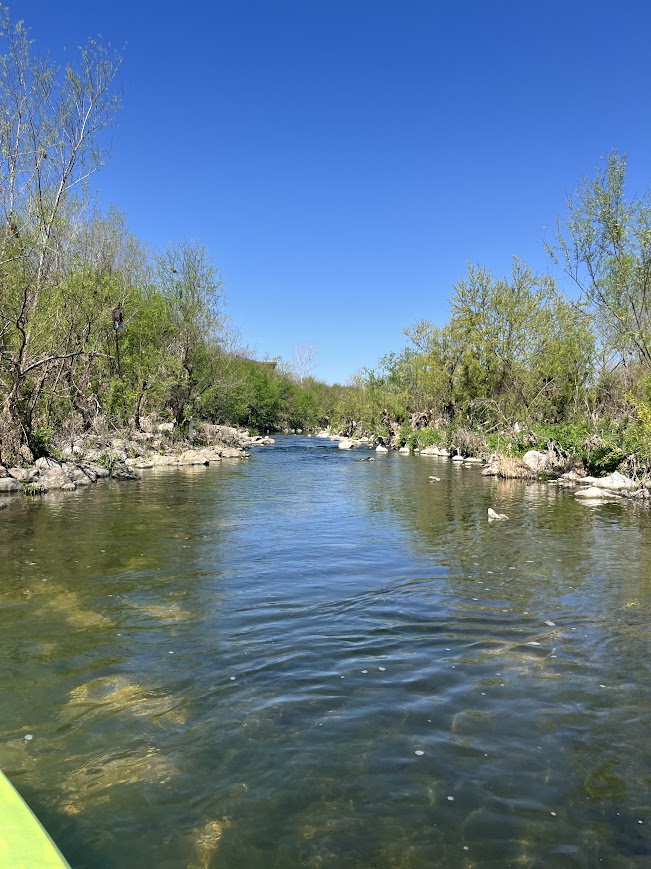
We can’t restore a river to conditions before the Industrial Revolution. But we can give the river the tools it needs to survive in this new era: namely, diversity. Our river restoration projects need to be sustainable: not just sustainable in the sense of eco-friendly, but sustainable in the sense of lasting for generations to come.
One of the current problems with river restoration efforts is the desire to create a specific environment designed to perform a specific function. But the best thing about rivers is that they don’t conform to a specific design. Rivers do what they want. And they are changing all the time. If we truly want to restore a river, maybe what we need to do is let go. (Figure 28)
Ecologists argue that restored rivers must incorporate variability into their designs to help rivers survive in the face of climate change and other human threats. Diverse ecosystems are more capable of bouncing back from disaster. 70 71 (Figure 29)
The biggest mistake humanity made was trying to force a river to run a specific way, to simplify it. To restore a river, you’ve got to let it be complex. You’ve got to let it be a little crazy. We’re the ones who the river builds, not the other way around.
~~~ References ~~~
- Gordon ND, McMahon TA, Finlayson B. 1992. Stream hydrology: an introduction for ecologists. Wiley. ↵
- Chiras DD, Reganold JP. 2010. Natural Resource Conservation: Management for a Sustainable Future. 10th edition. Pearson Prentice Hall. ↵
- Gamble R, Hogan T. 2019. Watersheds in watersheds: The fate of the planet’s major river systems in the Great Acceleration. Thesis Eleven. 150(1):3–25. https://journals.sagepub.com/doi/10.1177/0725513619826190. ↵
- Gordon ND, McMahon TA, Finlayson B. 1992. Stream hydrology: an introduction for ecologists. Wiley. ↵
- Gordon ND, McMahon TA, Finlayson B. 1992. Stream hydrology: an introduction for ecologists. Wiley. ↵
- Gamble R, Hogan T. 2019. Watersheds in watersheds: The fate of the planet’s major river systems in the Great Acceleration. Thesis Eleven. 150(1):3–25. https://journals.sagepub.com/doi/10.1177/0725513619826190. ↵
- History of the San Antonio River Authority. San Antonio River Authority. (accessed 2025 Nov. 1). https://www.sariverauthority.org/about/history/. ↵
- Noonan Guerra, M. Indians of the San Antonio River: Yanaguana. Journal of the Life and Culture of San Antonio. (accessed 2025 Nov 3). https://www.uiw.edu/sanantonio/IndiansofSanAntonioRiver.html. ↵
- Noonan Guerra, M. Indians of the San Antonio River: Yanaguana. Journal of the Life and Culture of San Antonio. (accessed 2025 Nov 3). https://www.uiw.edu/sanantonio/IndiansofSanAntonioRiver.html. ↵
- Chiras DD, Reganold JP. 2010. Natural Resource Conservation: Management for a Sustainable Future. 10th edition. Pearson Prentice Hall. ↵
- Gordon ND, McMahon TA, Finlayson B. 1992. Stream hydrology: an introduction for ecologists. Wiley. ↵
- Gamble R, Hogan T. 2019. Watersheds in watersheds: The fate of the planet’s major river systems in the Great Acceleration. Thesis Eleven. 150(1):3–25. https://journals.sagepub.com/doi/10.1177/0725513619826190. ↵
- Gamble R, Hogan T. 2019. Watersheds in watersheds: The fate of the planet’s major river systems in the Great Acceleration. Thesis Eleven. 150(1):3–25. https://journals.sagepub.com/doi/10.1177/0725513619826190. ↵
- Gamble R, Hogan T. 2019. Watersheds in watersheds: The fate of the planet’s major river systems in the Great Acceleration. Thesis Eleven. 150(1):3–25. https://journals.sagepub.com/doi/10.1177/0725513619826190. ↵
- McCool, D. 2012. River republic : the fall and rise of America’s rivers. Columbia University Press. ↵
- McCool, D. 2012. River republic : the fall and rise of America’s rivers. Columbia University Press. ↵
- Gamble R, Hogan T. 2019. Watersheds in watersheds: The fate of the planet’s major river systems in the Great Acceleration. Thesis Eleven. 150(1):3–25. https://journals.sagepub.com/doi/10.1177/0725513619826190. ↵
- Pradilla G, Hack J. 2024. An urban rivers renaissance? Stream restoration and green–blue infrastructure in Latin America – Insights from urban planning in Colombia. Urban Ecosystems. 27(6):2245–2265. https://doi.org/10.1007/s11252-024-01571-9. ↵
- History of the San Antonio River Authority. San Antonio River Authority. (accessed 2025 Nov. 1). https://www.sariverauthority.org/about/history/. ↵
- McCool, D. 2012. River republic : the fall and rise of America’s rivers. Columbia University Press. ↵
- Donald Hyndman and David Hyndman. 2025. Natural Hazards and Disasters. 6th edition. Cengage Learning. ↵
- Donald Hyndman and David Hyndman. 2025. Natural Hazards and Disasters. 6th edition. Cengage Learning. ↵
- Pradilla G, Hack J. 2024. An urban rivers renaissance? Stream restoration and green–blue infrastructure in Latin America – Insights from urban planning in Colombia. Urban Ecosystems. 27(6):2245–2265. https://doi.org/10.1007/s11252-024-01571-9. ↵
- History of the San Antonio River Authority. San Antonio River Authority. (accessed 2025 Nov. 1). https://www.sariverauthority.org/about/history/. ↵
- Gordon ND, McMahon TA, Finlayson B. 1992. Stream hydrology: an introduction for ecologists. Wiley. ↵
- McCool, D. 2012. River republic : the fall and rise of America’s rivers. Columbia University Press. ↵
- McCool, D. 2012. River republic : the fall and rise of America’s rivers. Columbia University Press. ↵
- Donald Hyndman and David Hyndman. 2025. Natural Hazards and Disasters. 6th edition. Cengage Learning. ↵
- Donald Hyndman and David Hyndman. 2025. Natural Hazards and Disasters. 6th edition. Cengage Learning. ↵
- Guimarães LF, Veról AP, Miguez MG. 2025. Assessing urban river restoration design using an integrated economic, social and environmental index. Journal of Cleaner Production. 486(144568). https://doi.org/10.1016/j.jclepro.2024.144568. ↵
- McCool, D. 2012. River republic : the fall and rise of America’s rivers. Columbia University Press. ↵
- Wohl E, Lane SN, Wilcox AC. 2015. The science and practice of river restoration. Water Resources Research. 51(8):5974–5997. https://doi.org/10.1002/2014WR016874. ↵
- McCool, D. 2012. River republic : the fall and rise of America’s rivers. Columbia University Press. ↵
- Platz MC, Bratton JF, Herman BD. 2025. US Army Corps of Engineers Aquatic Restoration Monitoring for Ecosystem Recovery (ARMER) Network. Engineer Research and Development Center (U.S.). (accessed 2025 Sep 10).https://dx.doi.org/10.21079/11681/49912. ↵
- History of the San Antonio River Authority. San Antonio River Authority. (accessed 2025 Nov. 1). https://www.sariverauthority.org/about/history/. ↵
- Westside Creeks Ecosystem Restoration – San Antonio, Texas. 2022. US Army Corps of Engineers: Fort Worth District. (accessed 2025 Sep 10). https://www.swf.usace.army.mil/Missions/Civil-Works/Westside-Creeks/. ↵
- Chen Y, Wang Y, Leung CCY, Hyeon PJ, Ding X. 2023. Urban river restoration in Hong Kong: Assessment, impact, and improvement strategies. Sustainable Cities and Society. 99:104885. https://doi.org/10.1016/j.scs.2023.104885. ↵
- Wynants M, Hallberg L, Prischl L-A, Livsey J, Bieroza M. 2025. Trends and purposes of European river monitoring and restoration. Environmental Science & Policy. 170:104130. https://doi.org/10.1016/j.envsci.2025.104130. ↵
- Enu KB, Zingraff-Hamed A, Lupp G, Raum S, Moors E, Pauleit S. 2025. Stakeholder priorities and navigating barriers in urban river restoration: Comparative insights from Germany and Ghana. Environmental and Sustainability Indicators. 26(100683). https://doi.org/10.1016/j.indic.2025.100683. ↵
- Weston P. 2022 Sep 20. “This is what a river should look like”: Dutch rewilding project turns back the clock 500 years. The Guardian. (accessed 2025 Sep 10). https://www.theguardian.com/environment/2022/sep/20/dutch-rewilding-project-turns-back-the-clock-500-years-aoe. ↵
- Weston P. 2022 Sep 20. “This is what a river should look like”: Dutch rewilding project turns back the clock 500 years. The Guardian. (accessed 2025 Sep 10). https://www.theguardian.com/environment/2022/sep/20/dutch-rewilding-project-turns-back-the-clock-500-years-aoe. ↵
- Pradilla G, Hack J. 2024. An urban rivers renaissance? Stream restoration and green–blue infrastructure in Latin America – Insights from urban planning in Colombia. Urban Ecosystems. 27(6):2245–2265. https://doi.org/10.1007/s11252-024-01571-9. ↵
- Pradilla G, Hack J. 2024. An urban rivers renaissance? Stream restoration and green–blue infrastructure in Latin America – Insights from urban planning in Colombia. Urban Ecosystems. 27(6):2245–2265. https://doi.org/10.1007/s11252-024-01571-9. ↵
- Wynants M, Hallberg L, Prischl L-A, Livsey J, Bieroza M. 2025. Trends and purposes of European river monitoring and restoration. Environmental Science & Policy. 170:104130. https://doi.org/10.1016/j.envsci.2025.104130. ↵
- Follstad Shah JJ, Dahm CN, Gloss SP, Bernhardt ES. 2007. River and Riparian Restoration in the Southwest: Results of the National River Restoration Science Synthesis Project. Restoration Ecology, 15(3), pp. 550–562. https://doi.org/10.1111/j.1526-100X.2007.00250.x. ↵
- Gordon ND, McMahon TA, Finlayson B. 1992. Stream hydrology: an introduction for ecologists. Wiley. ↵
- History of the San Antonio River Authority. San Antonio River Authority. (accessed 2025 Nov. 1). https://www.sariverauthority.org/about/history/. ↵
- Basic Information about Nonpoint Source Pollution. 2015, Sept. 15. US Environmental Protection Agency. Archived on 2025, Jan. 1. https://web.archive.org/web/20250101220146/https://www.epa.gov/nps/basic-information-about-nonpoint-source-nps-pollution. ↵
- Wohl E, Lane SN, Wilcox AC. 2015. The science and practice of river restoration. Water Resources Research. 51(8):5974–5997. https://doi.org/10.1002/2014WR016874. ↵
- Wohl E, Lane SN, Wilcox AC. 2015. The science and practice of river restoration. Water Resources Research. 51(8):5974–5997. https://doi.org/10.1002/2014WR016874. ↵
- Stream Restoration. San Antonio River Authority. (accessed 2025 Sep 3). https://www.sariverauthority.org/services/sustainability/stream-restoration/. ↵
- Follstad Shah JJ, Dahm CN, Gloss SP, Bernhardt ES. 2007. River and Riparian Restoration in the Southwest: Results of the National River Restoration Science Synthesis Project. Restoration Ecology, 15(3), pp. 550–562. https://doi.org/10.1111/j.1526-100X.2007.00250.x. ↵
- Marks JC. 2007. Down Go the Dams. Scientific American Magazine. 296(3). (accessed 2025 Oct 19). https://www.scientificamerican.com/article/down-go-the-dams/. ↵
- Marks JC. 2007. Down Go the Dams. Scientific American Magazine. 296(3). (accessed 2025 Oct 19). https://www.scientificamerican.com/article/down-go-the-dams/. ↵
- Follstad Shah JJ, Dahm CN, Gloss SP, Bernhardt ES. 2007. River and Riparian Restoration in the Southwest: Results of the National River Restoration Science Synthesis Project. Restoration Ecology, 15(3), pp. 550–562. https://doi.org/10.1111/j.1526-100X.2007.00250.x. ↵
- Darre ME, Domisch S, Hermoso V, Ørsted M, Arsanjani JJ. 2025. Optimizing River Restoration: A Multi-Scenario Approach to Barrier Removal Prioritization. Journal of Environmental Management. https://doi.org/10.1016/j.jenvman.2025.126176. ↵
- Greene RH, Thoms MC, Parsons M. 2023. We cannot turn back time: a framework for restoring and repairing rivers in the Anthropocene. Front Environ Sci. 11:1162908. https://doi.org/10.3389/fenvs.2023.1162908. ↵
- Pradilla G, Hack J. 2024. An urban rivers renaissance? Stream restoration and green–blue infrastructure in Latin America – Insights from urban planning in Colombia. Urban Ecosystems. 27(6):2245–2265. https://doi.org/10.1007/s11252-024-01571-9. ↵
- Greene RH, Thoms MC, Parsons M. 2023. We cannot turn back time: a framework for restoring and repairing rivers in the Anthropocene. Front Environ Sci. 11:1162908. https://doi.org/10.3389/fenvs.2023.1162908. ↵
- Gordon ND, McMahon TA, Finlayson B. 1992. Stream hydrology: an introduction for ecologists. Wiley. ↵
- Wohl E, Lane SN, Wilcox AC. 2015. The science and practice of river restoration. Water Resources Research. 51(8):5974–5997. https://doi.org/10.1002/2014WR016874. ↵
- Stream Restoration. San Antonio River Authority. (accessed 2025 Sep 3). https://www.sariverauthority.org/services/sustainability/stream-restoration/. ↵
- Dong Y. 2024 Dec 7. Revealing the willingness-to-pay for river restoration in China: a meta-analysis. Environment, Development and Sustainability: A Multidisciplinary Approach to the Theory and Practice of Sustainable Development.:1–27. https://doi.org/10.1007/s10668-024-05787-9. ↵
- Wohl E, Lane SN, Wilcox AC. 2015. The science and practice of river restoration. Water Resources Research. 51(8):5974–5997. https://doi.org/10.1002/2014WR016874. ↵
- History of the San Antonio River Authority. San Antonio River Authority. (accessed 2025 Nov. 1). https://www.sariverauthority.org/about/history/. ↵
- Pradilla G, Hack J. 2024. An urban rivers renaissance? Stream restoration and green–blue infrastructure in Latin America – Insights from urban planning in Colombia. Urban Ecosystems. 27(6):2245–2265. https://doi.org/10.1007/s11252-024-01571-9. ↵
- Chen Y, Wang Y, Leung CCY, Hyeon PJ, Ding X. 2023. Urban river restoration in Hong Kong: Assessment, impact, and improvement strategies. Sustainable Cities and Society. 99:104885. https://doi.org/10.1016/j.scs.2023.104885. ↵
- Enu KB, Zingraff-Hamed A, Lupp G, Raum S, Moors E, Pauleit S. 2025. Stakeholder priorities and navigating barriers in urban river restoration: Comparative insights from Germany and Ghana. Environmental and Sustainability Indicators. 26(100683). https://doi.org/10.1016/j.indic.2025.100683. ↵
- Wohl E, Lane SN, Wilcox AC. 2015. The science and practice of river restoration. Water Resources Research. 51(8):5974–5997. https://doi.org/10.1002/2014WR016874. ↵
- Wohl E, Lane SN, Wilcox AC. 2015. The science and practice of river restoration. Water Resources Research. 51(8):5974–5997. https://doi.org/10.1002/2014WR016874. ↵
- Greene RH, Thoms MC, Parsons M. 2023. We cannot turn back time: a framework for restoring and repairing rivers in the Anthropocene. Front Environ Sci. 11:1162908. https://doi.org/10.3389/fenvs.2023.1162908. ↵
